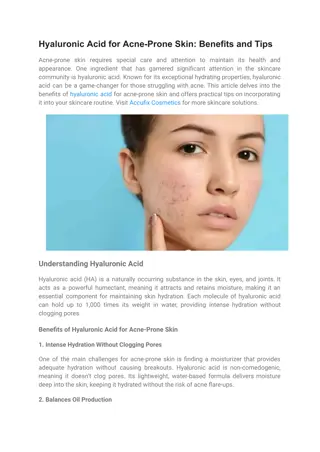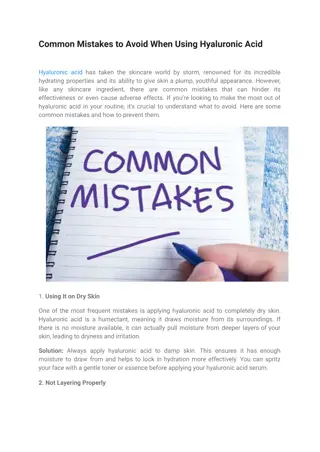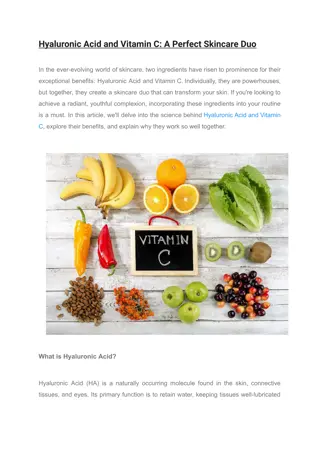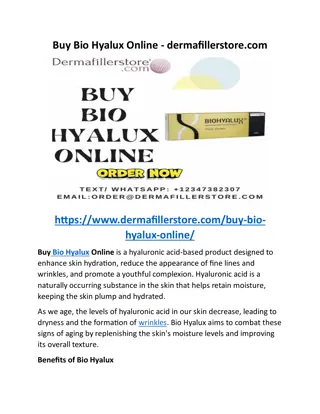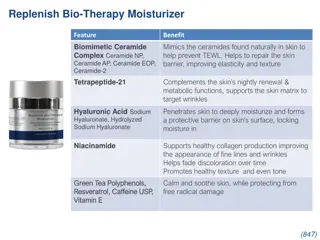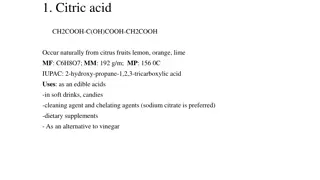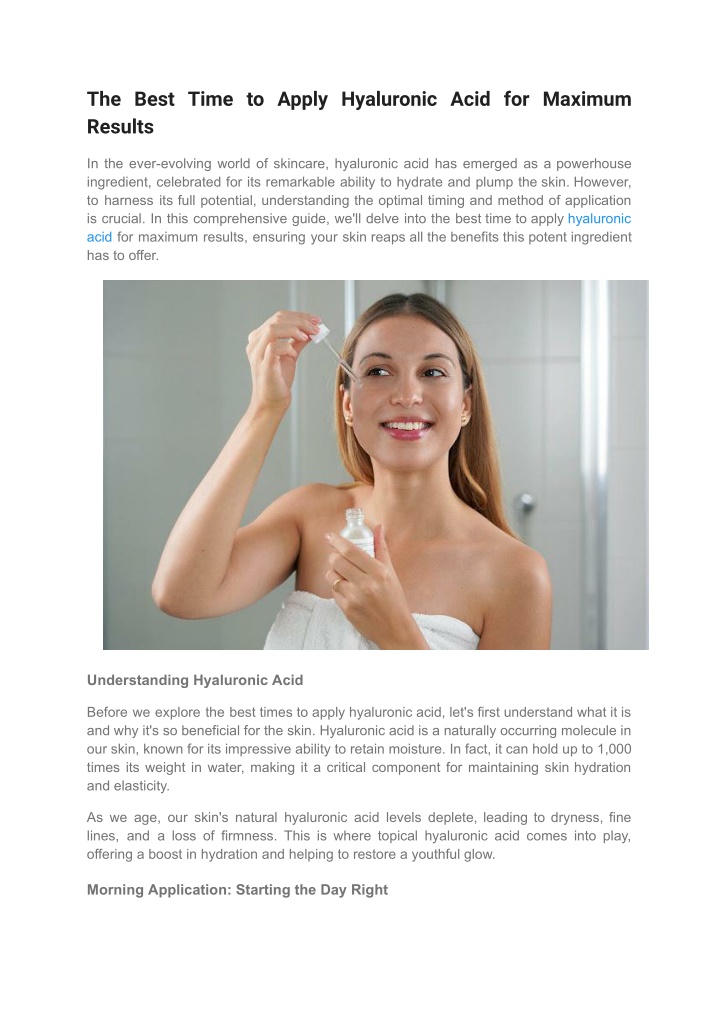
The Best Time to Apply Hyaluronic Acid for Maximum Results
In the ever-evolving world of skincare, hyaluronic acid has emerged as a powerhouse ingredient, celebrated for its remarkable ability to hydrate and plump the skin. However, to harness its full potential, understanding the optimal timing and method o
Download Presentation

Please find below an Image/Link to download the presentation.
The content on the website is provided AS IS for your information and personal use only. It may not be sold, licensed, or shared on other websites without obtaining consent from the author. If you encounter any issues during the download, it is possible that the publisher has removed the file from their server.
You are allowed to download the files provided on this website for personal or commercial use, subject to the condition that they are used lawfully. All files are the property of their respective owners.
The content on the website is provided AS IS for your information and personal use only. It may not be sold, licensed, or shared on other websites without obtaining consent from the author.
E N D
Presentation Transcript
The Best Time to Apply Hyaluronic Acid for Maximum Results In the ever-evolving world of skincare, hyaluronic acid has emerged as a powerhouse ingredient, celebrated for its remarkable ability to hydrate and plump the skin. However, to harness its full potential, understanding the optimal timing and method of application is crucial. In this comprehensive guide, we'll delve into the best time to apply hyaluronic acid for maximum results, ensuring your skin reaps all the benefits this potent ingredient has to offer. Understanding Hyaluronic Acid Before we explore the best times to apply hyaluronic acid, let's first understand what it is and why it's so beneficial for the skin. Hyaluronic acid is a naturally occurring molecule in our skin, known for its impressive ability to retain moisture. In fact, it can hold up to 1,000 times its weight in water, making it a critical component for maintaining skin hydration and elasticity. As we age, our skin's natural hyaluronic acid levels deplete, leading to dryness, fine lines, and a loss of firmness. This is where topical hyaluronic acid comes into play, offering a boost in hydration and helping to restore a youthful glow. Morning Application: Starting the Day Right
Applying hyaluronic acid in the morning can set the stage for a day of radiant, hydrated skin. Here s why the morning might be the perfect time for this essential step in your skincare routine: 1. Hydration Boost: Starting your day with hyaluronic acid ensures your skin is well-hydrated, combating the drying effects of environmental factors like air conditioning and pollution. 2. Enhanced Makeup Application: Well-hydrated skin provides a smooth canvas for makeup, allowing for better application and longevity. 3. Antioxidant Protection: Many hyaluronic acid serums are formulated with additional antioxidants, offering an extra layer of protection against free radicals and UV damage throughout the day. How to Apply in the Morning 1. Cleanse: Begin with a gentle cleanser to remove any impurities that accumulated overnight. 2. Toner (Optional): If you use a toner, apply it after cleansing to prep your skin. 3. Hyaluronic Acid Serum: While your skin is still slightly damp, apply a few drops of hyaluronic acid serum. This helps to lock in moisture. 4. Moisturizer: Follow with a hydrating moisturizer to seal in the serum. 5. Sunscreen: Never skip sunscreen in the morning. It s essential for protecting your skin from UV damage. Evening Application: Repair and Rejuvenate Nighttime is when your skin goes into repair mode, making it an ideal time to apply hyaluronic acid. Here s why incorporating it into your evening routine can be highly beneficial:
1. Deep Hydration: Applying hyaluronic acid before bed allows your skin to absorb and retain moisture more effectively, addressing any dryness that occurred during the day. 2. Repair and Rejuvenate: During sleep, your skin s natural repair processes are at their peak. Hyaluronic acid can support these processes, promoting a more youthful complexion. 3. Complementary Ingredients: Many nighttime skincare products contain complementary ingredients like retinol or peptides, which work synergistically with hyaluronic acid to enhance skin repair and regeneration. How to Apply in the Evening 1. Cleanse: Remove makeup and impurities with a gentle cleanser. 2. Toner (Optional): Apply a toner if it s part of your routine. 3. Hyaluronic Acid Serum: Apply your hyaluronic acid serum while your skin is slightly damp. 4. Treatment Products: If you use treatments like retinol or other serums, apply them next. Hyaluronic acid pairs well with many active ingredients, enhancing their absorption and efficacy. 5. Moisturizer: Finish with a rich, hydrating moisturizer to lock in all the goodness. Post-Cleansing: The Ideal State for Hyaluronic Acid Regardless of whether you choose to apply hyaluronic acid in the morning, evening, or both, one crucial factor remains consistent: the state of your skin post-cleansing. Hyaluronic acid works best when applied to slightly damp skin. This allows it to bind water to the skin more effectively, maximizing its hydrating benefits. Seasonal Considerations The time of year can also influence the best time to apply hyaluronic acid: Winter: During the colder months, your skin tends to lose more moisture due to dry indoor heating and harsh weather. Applying hyaluronic acid both morning and night can provide an extra hydration boost. Summer: In the warmer months, your skin may not require as much hydration. A morning application might suffice, especially if you have oily skin. Skin Type Considerations Your skin type can also play a role in determining the best time to apply hyaluronic acid: Dry Skin: If you have dry skin, applying hyaluronic acid both morning and night can help maintain optimal hydration levels. Oily Skin: Those with oily skin might prefer using hyaluronic acid in the morning to avoid feeling too heavy or greasy at night. Combination Skin: For combination skin, you can apply hyaluronic acid to dry areas both morning and night, and to oilier areas in the morning only.
Layering with Other Products Hyaluronic acid is a versatile ingredient that works well with a variety of other skincare products. When layering, the general rule is to apply products from thinnest to thickest consistency: 1. Cleanser 2. Toner 3. Hyaluronic Acid Serum 4. Treatment Serums (like Vitamin C or Retinol) 5. Moisturizer 6. Sunscreen (morning routine) Conclusion Understanding the best time to apply hyaluronic acid can significantly enhance its effectiveness, leading to plumper, more hydrated skin. Whether you incorporate it into your morning routine to combat daily environmental stressors or use it at night to support your skin s natural repair processes, hyaluronic acid is a versatile and powerful addition to any skincare regimen. For more expert skincare tips and to explore a range of products designed to enhance your skin s health and radiance, visit Accufix Cosmetics. Embrace the power of hyaluronic acid and achieve the glowing, youthful complexion you ve always desired.










